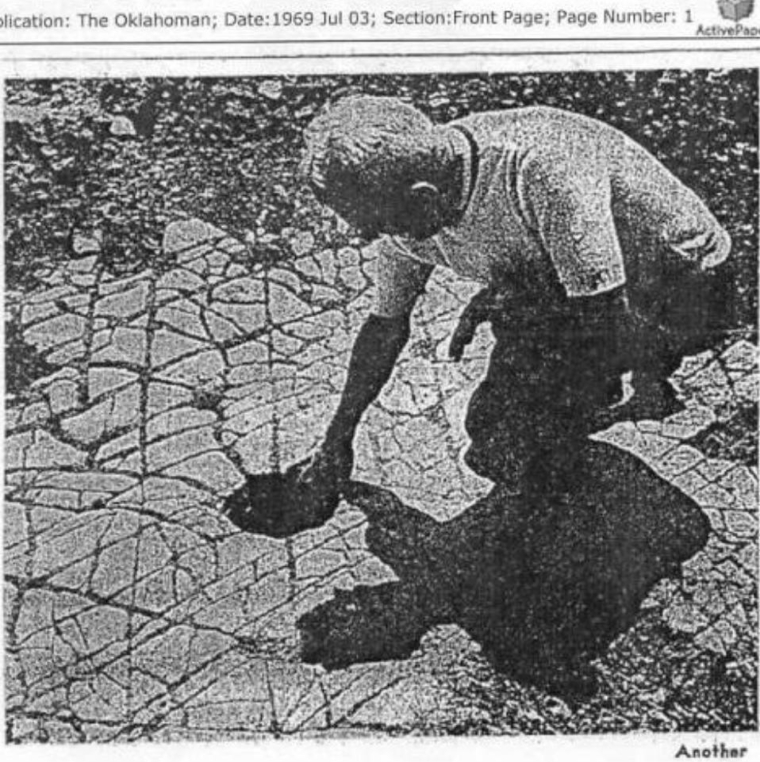In 1969, construction personnel in Oklahoma, USA, came across a peculiar formation that seemed to be artificially constructed and, as many experts claim, had the possibility to change the perception of not only the history of the United States but also the history of the entire world.

This formation, which is similar to a stone floor made of tiny pieces, was uncovered in a layer that experts assume to be from 200 thousand years ago. At the same time, it is commonly believed that the earliest human civilization in North America appeared only 22-19 thousand years ago.
Soon after its discovery, a newspaper, “The Oklahoman” published an article about this extraordinary discovery, which led to heated debates among experts and the general public. The story also featured three black and white photographs of this “mosaic,” which are still the only existing images of this object.
The following is an excerpt from the news report:
“On June 27, 1969, while working on a rock formation located on the Broadway Extension of 122nd Street, between Edmond and Oklahoma City, construction workers made an unexpected discovery that sparked debate among experts.
I am confident that it is of human origin as the stones were arranged in precise sets of parallel lines that intersected to form a diamond shape, all facing east,” said Durwood Pate, an Oklahoma City geologist who examined the site thoroughly.
We also found a hole that appears to be for a pole or pillar, it is perfectly flat. The top of the rocks is extremely smooth and upon examination, it shows signs of surface wear. Everything is too well-positioned to be a natural formation, he added.”

The University of Oklahoma archaeologist Dr. Robert Bell held a differing viewpoint, asserting that the discovery was a natural occurrence. He stated that there were no indications of any deliberate shaping or construction. However, Pate, a geologist, found what seemed to be a type of grout, a material used to fill gaps in building structures, between each stone.
The structure, located roughly 90 centimeters below the surface, appears to cover a large area, as reported by Delbert Smith, president of the Oklahoma Seismograph Company, and past president of the Oklahoma City Geophysical Society. “There is no doubt that it was intentionally constructed, but I cannot say who or what built it,” Smith stated to the reporter.
Smith and Pate traveled to the location to investigate the formation and gather samples, according to the news article. “I am certain that this is not a natural formation, but rather, something made by human hands,” Smith said later.
Two days after the initial discovery, on June 29, 1969, another article about the find was published in the “Tulsa World” newspaper. In this article, Delbert Smith’s statements were more detailed and the age of the object was mentioned for the first time.
“There’s no doubt about that. It was specially installed by someone, but I have no idea who did it.”
“Another facet of the mystery is related to the dating. There are different opinions regarding the geology involved, but the most accurate estimates of the age of these tiles are 200 thousand years.”

The examination continued, and on July 1, 1969, The Oklahoman reported the discovery of a second hole in the “mosaic.” According to measurements, the two holes were found to be five meters apart. Pate stated that the rock used in the mosaic was a combination of Permian limestone and quartz grains.
On July 3, The Oklahoman newspaper continued to report on the discovery and stated that, according to reports from archaeologists, an “ancient stone hammer” was also discovered at the site.
“The mystery of the dolomite limestone formation discovered between Oklahoma City and Edmond was exacerbated Wednesday by the discovery of a hammer-like object at the site.”
The geologists who examined the strange formation found it challenging to determine its origin. John M. Ware, a geologist from Oklahoma City, stated: “It is beyond the realm of geology to explain – we require an archaeologist to give a conclusive evaluation. However, if an archaeologist does not take up the project soon, its age and origins may remain an enigma.”
“In the next 20 days, the excavation team will carry on their work on the site to prepare for the construction of a food storage facility. Another intriguing aspect of the rock is that it contains marine sediments, which suggests that it was once part of the ocean floor.”
Pate also mentioned that “the 100-by-60-foot formation is quickly becoming a popular tourist destination.”
“Many people are visiting the site and taking pieces of the stone. It is important that we protect it until its origins can be determined.”
Sadly, there is very little information available about this strange discovery in Oklahoma media after that and what happened to it remains unknown to this day.



